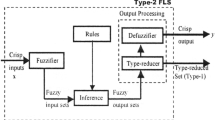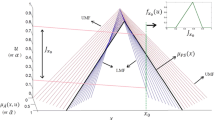Abstract
The Karnik–Mendel (KM) or the enhanced Karnik–Mendel (EKM) algorithm is widely used for interval type-2 fuzzy sets type reduction in many applications. Compared with iterative procedures of KM/EKM, an iterative algorithm with a stop condition or an enhanced iterative algorithm with a stop condition based on the KM algorithm that converges monotonically is more efficient. In this article, a new iterative algorithm with stop condition type reduction for interval type-2 fuzzy sets is proposed, in which switch points are initialized and unidirectional search is performed based on monotone properties of the KM algorithm. Furthermore, the proposed algorithm is applied to general type-2 fuzzy sets type reduction based on α-plane representation. The experimental results of a triangular and gaussian secondary membership function show practicality and efficiency of this method. In accordance with the conventional PI, type-1 or interval type-2 fuzzy controller is difficult to achieve a desired control effect for steam temperature at collector outlet of trough solar thermal power generation system with large time delay, strong inertia and parameter time-variation, and a general type-2 fuzzy controller with more adjustable controller parameters is proposed in this article. In different working conditions, the proposed controller can reduce system overshoot and ensure system stability. Moreover, when the working condition changes, the controller can solve a model mismatch problem under same controller parameters and has faster response.
























Similar content being viewed by others
References
Baykasoglu A, Altun K, Durmusoglu A (2011) Review: industrial applications of type-2 fuzzy sets and systems: a concise review. Comput Ind 62(2):125–137
Castillo O, Melin P (2012) A review on the design and optimization of interval type-2 fuzzy controllers. Appl Soft Comput 12(4):1267–1278
Castillo O, Melin P (2014) A review on interval type-2 fuzzy logic applications in intelligent control. Inf Sci 279:615–631
Duran K, Bernal H, Melgarejo M (2008) Improved iterative algorithm for computing the generalized centroid of an interval type-2 fuzzy set. In: Annual meeting of the North American fuzzy information processing society, pp 1–5
Guo S, Liu DY, Zhang YM et al (2012) Research on control strategy of outlet steam temperature for DSG in parabolic troughs solar power under recirculation operation mode. Proc Chin Soc Electr Eng 32(20):62–68
Karnik NN, Mendel JM (2001) Centroid of a type-2 fuzzy set. Inf Sci 132:195–220
Liu F (2008) An efficient centroid type-reduction strategy for general type-2 fuzzy logic system. Inf Sci 178(9):2224–2236
Mendel JM (2010) Comments on “α-Plane representation for type-2 fuzzy sets: theory and applications”. IEEE Trans Fuzzy Syst 18(1):229–230
Mendel JM (2013) On KM algorithms for solving type-2 fuzzy set problems. IEEE Trans Fuzzy Syst 21(3):426–446
Mendel JM, Liu F (2007) Super-exponential convergence of the Karnik–Mendel algorithms for computing the centroid of an interval type-2 fuzzy set. IEEE Trans Fuzzy Syst 15(2):309–320
Mendel JM, Liu F, Zhai D (2009) α-plane representation for type-2 fuzzy sets: theory and applications. IEEE Trans Fuzzy Syst 17(5):1189–1207
Valenzuela L, Zarza E, Berenguel M et al (2004) Direct steam generation in solar boilers. IEEE Control Syst Mag 24(2):15–29
Valenzuela L, Zarza E, Berenguel M et al (2006) Control scheme for direct steam generation in parabolic troughs under recirculation operation mode. Sol Energy 80(1):1–17
Wagner C, Hagras H (2008) z Slices—towards bridging the gap between interval and general type-2 fuzzy logic. In: IEEE international conference on fuzzy systems, pp 489–457
Wagner C, Hagras H (2010) Towards general type-2 fuzzy logic systems based on zSlices. IEEE Trans Fuzzy Syst 18(4):637–660
Wu D, Mendel JM (2009) Enhanced Karnik–Mendel algorithms. IEEE Trans Fuzzy Syst 17(4):923–934
Wu D, Nie M (2011) Comparison and practical implementation of type-reduction algorithms for type-2 fuzzy sets and systems. In: IEEE international conference on fuzzy systems, pp 2131–2138
Wu HJ, Su YL, Lee SJ (2012) A fast method for computing the centroid of a type-2 fuzzy set. IEEE Trans Syst Man Cybern Part B Cybern 42(3):764–777
Yeh CH, Roger WH, Lee SJ (2011) An enhanced type-reduction algorithm for type-2 fuzzy sets. IEEE Trans Fuzzy Syst 19(2):227–240
Funding
This study was funded by the scientific research fund project of Nanjing Institute of Technology (YKJ201523, YKJ201408, QKJA201504).
Author information
Authors and Affiliations
Corresponding author
Ethics declarations
Conflict of interest
Shi Jianzhong has received research grants from Nanjing Institute of Technology. Liang Shaohua has received research grants from Nanjing Institute of Technology. Yang Yong has received research grants from Nanjing Institute of Technology. Shi Jianzhong declares that he has no conflict of interest. Liang Shaohua declares that he has no conflict of interest. Yang Yong declares that she has no conflict of interest. Li Rong declares that he has no conflict of interest.
Human and animal rights
This article does not contain any studies with human participants or animals performed by any of the authors.
Informed consent
Informed consent was obtained from all individual participants included in the study.
Additional information
Communicated by V. Loia.
Publisher’s Note
Springer Nature remains neutral with regard to jurisdictional claims in published maps and institutional affiliations.
Rights and permissions
About this article
Cite this article
Jianzhong, S., Shaohua, L., Yong, Y. et al. An improved general type-2 fuzzy sets type reduction and its application in general type-2 fuzzy controller design. Soft Comput 23, 13513–13530 (2019). https://doi.org/10.1007/s00500-019-03889-5
Published:
Issue Date:
DOI: https://doi.org/10.1007/s00500-019-03889-5




